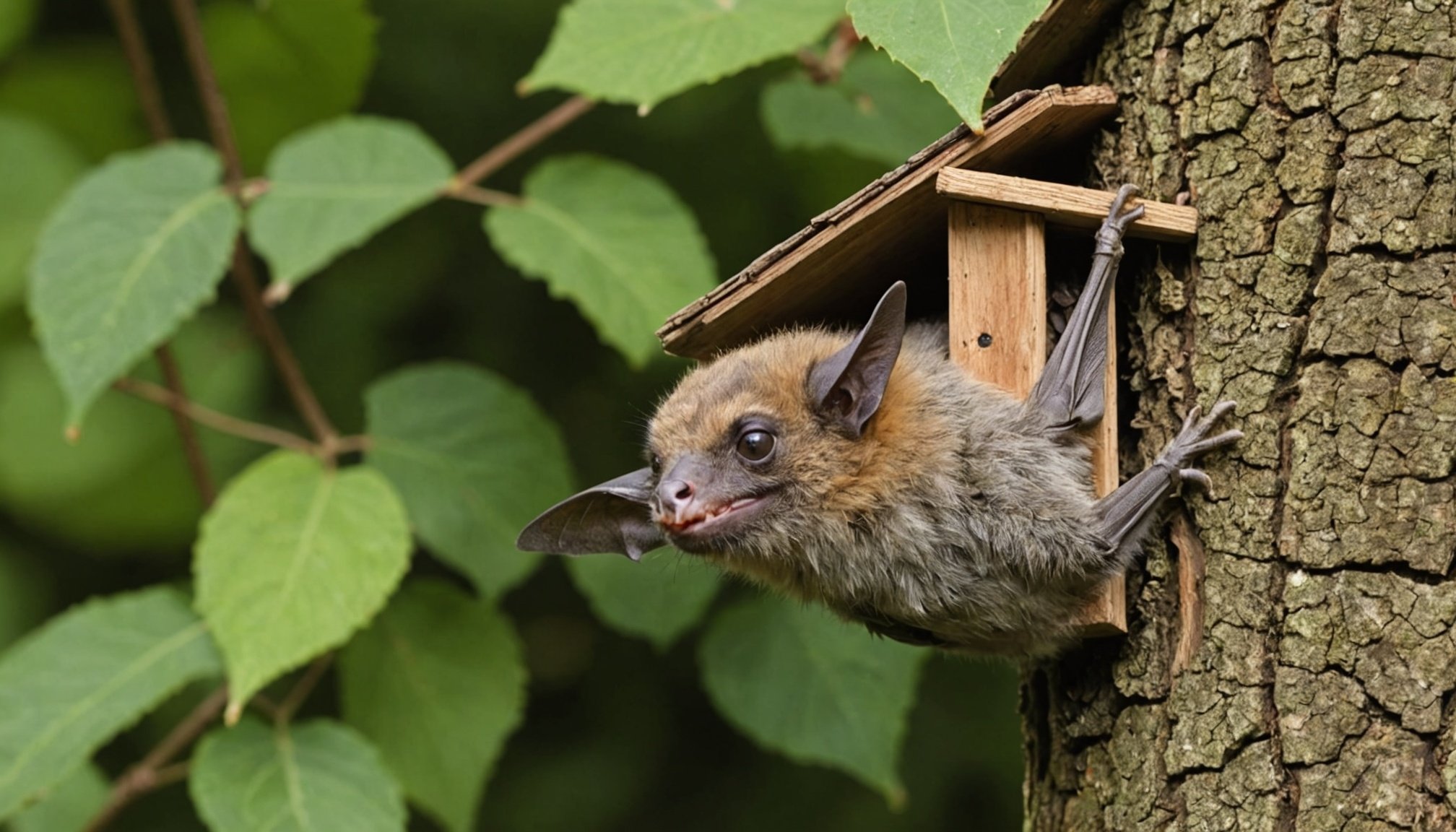Unlock the Secrets of UK Bat Species: Your Ultimate Guide to Supporting Local Wildlife with Bat Boxes
Why Bats are Crucial for Your Garden and Local Wildlife
Bats are often overlooked but are incredibly vital to the health of our ecosystems. These nocturnal creatures play a significant role in controlling insect populations, pollination, and even seed dispersal. In the UK, with its diverse range of bat species, creating a bat-friendly garden can be a rewarding and environmentally beneficial endeavor.
“Bats are essential in controlling insect populations. Certain bat species can consume thousands of insects in a single night, acting as natural pest controllers,” notes a conservation expert from the Bat Conservation Trust[3].
This might interest you : Top tips for preventing and healing saddle sores in shetland ponies: a comprehensive guide
Understanding Bat Habitats and Preferences
Before you can support bats in your garden, it’s essential to understand their habitats and preferences. The UK is home to 18 resident bat species, each with unique requirements.
- Woodlands and Trees: Species like the noctule and Bechstein’s bat thrive in wooded areas, often roosting in tree cavities and woodpecker holes. Incorporating plants like willow and oak into your garden provides essential cover and roosting opportunities for these bats[1].
- Wetlands and Rivers: Soprano pipistrelles favor wetland habitats, especially near rivers. Creating a small pond or water feature in your garden can support insect populations that these bats depend on for nutrition[1].
- Urban Areas: Common pipistrelles and serotines can be found in urban environments, roosting in old buildings, churches, and trees. Installing bat boxes in these areas can provide safe roosting options[1].
Designing a Bat-Friendly Garden
Creating a bat-friendly garden involves several key elements:
Also to discover : Recognizing dehydration in your reptiles: essential signs and prevention strategies for a thriving habitat
Incorporating Native Plants
Native plants are crucial for attracting bats because they provide a familiar environment where bats can efficiently forage. Here are some native plants that are beneficial for bats:
- Evening Primrose: Blooms at night, attracting insects when bats are most active.
- Honeysuckle: Releases fragrances appealing to nocturnal creatures.
- Wild Bergamot: Attracts a variety of insects, a primary food source for many bat species[2].
Avoiding Pesticides
Pesticides and herbicides can harm bats by reducing their food sources. Opting for natural pest control methods and avoiding chemical treatments can create a more sustainable environment beneficial to bats.
Water Management
Creating ponds or wetlands can attract insects, providing a feeding ground for bats. These water features support the ecological balance and serve as critical resources in drier seasons[2].
The Importance of Bat Boxes
Bat boxes are a simple yet effective way to support bat populations in your garden. Here’s how you can make the most of them:
Choosing the Right Bat Box
Different bat species have different preferences when it comes to roosting sites. Here are some tips for choosing the right bat box:
- Species-Specific Designs: Some bat boxes are designed specifically for certain species. For example, the common pipistrelle and soprano pipistrelle prefer boxes with narrower slits, while the noctule and Bechstein’s bat prefer boxes with wider entrances[1].
- Material and Construction: Bat boxes can be made from various materials, including wood and plastic. Wood is generally preferred because it provides better insulation. Ensure the box is well-ventilated and has a smooth interior to prevent bats from getting injured[2].
Installing Bat Boxes
The installation of bat boxes is crucial for their effectiveness:
- Height and Orientation: Install bat boxes at least 12 to 15 feet above the ground, in locations that receive ample sunlight. This helps in maintaining a warm temperature inside the box, which is essential for bat roosting[3].
- Location: Place bat boxes in areas that are sheltered from strong winds and predators. Trees, walls, and fences are good locations[2].
Community Involvement and Conservation Efforts
Supporting local bat species is not just an individual effort but also a community endeavor.
Engaging with Local Wildlife Groups
Engage with local wildlife groups and participate in bat conservation activities. Many organizations, like the Bat Conservation Trust, run volunteer programs to monitor and protect bat habitats. These initiatives not only raise awareness but also mobilize resources and collective efforts towards meaningful conservation outcomes[1].
Hosting Workshops and Events
Hosting workshops or talks can raise awareness about the importance of bats in the local ecosystem. Organizing bat-watching events allows participants to observe bats in their natural habitat, sparking curiosity and a sense of responsibility towards these creatures[3].
Practical Steps for Supporting Bat Populations
Here are some practical steps you can take to support bat populations in your garden:
Creating a Diverse Garden
- Plant Native Trees and Shrubs: Incorporate plants that attract insects, which serve as a food source for bats.
- Maintain a Small Pond: Support insect populations by creating a small pond or water feature.
- Avoid Pesticides: Preserve a healthy insect network by avoiding the use of pesticides in your garden[1].
Installing DIY Bat Houses
- Use the Right Materials: Opt for wood or other natural materials that provide good insulation.
- Monitor Occupancy: Keep an eye on the occupancy of the bat houses to ensure they are being used effectively[3].
Real-Life Examples of Successful Community Efforts
Several community-led initiatives have shown significant success in supporting bat populations.
Case Study: Devon, UK
In Devon, a local group transformed an abandoned barn into a thriving bat habitat. This project not only increased bat populations but also boosted eco-tourism, enhancing the local economy[3].
Case Study: London, UK
The Bat Conservation Trust collaborated with residents in London to monitor urban bat activity. Their efforts led to the discovery of several previously undocumented bat species, highlighting the power of community action in biodiversity preservation[3].
Legal Protections and Conservation Efforts
Bats in the UK are protected under robust legislation.
Conservation of Habitats and Species Regulations 2017
This legislation makes it an offense to disturb bats or damage their habitats, underscoring the importance of wildlife legislation in preserving these species[2].
Role of the Bat Conservation Trust
The Bat Conservation Trust is a leading organization in bat conservation, offering resources, guidance, and spearheading initiatives. They undertake widespread monitoring programs and provide essential support to local conservation efforts[4].
Supporting local bat species is a rewarding and environmentally beneficial endeavor. By understanding their habitats, incorporating native plants, avoiding pesticides, and installing bat boxes, you can create a bat-friendly garden that enhances local biodiversity.
As Merlin Tuttle, a renowned bat conservationist, once said, “Bats are not just interesting creatures; they are vital components of our ecosystems. By supporting them, we support the health of our environment.”
So, take the first step today. Make your garden a haven for these nocturnal creatures, and contribute to the conservation of these vital species.
Table: Comparison of Different Bat Box Designs
| Bat Box Type | Species Preference | Material | Installation Height | Orientation |
|---|---|---|---|---|
| Narrow Slit Box | Common Pipistrelle, Soprano Pipistrelle | Wood or Plastic | 12-15 feet above ground | South-facing |
| Wide Entrance Box | Noctule, Bechstein’s Bat | Wood | 12-15 feet above ground | South-facing |
| Multi-Chamber Box | Various Species | Wood or Plastic | 12-15 feet above ground | South-facing |
| Roof-Mounted Box | Urban Species like Serotine | Wood or Plastic | On roof or wall | Sheltered from wind |
Detailed Bullet Point List: Tips for Creating a Bat-Friendly Garden
- Incorporate Native Plants:
- Plant evening primrose, honeysuckle, and wild bergamot to attract insects.
- Use plants that bloom at night to attract nocturnal insects.
- Avoid Pesticides:
- Opt for natural pest control methods.
- Avoid using herbicides and chemical treatments.
- Water Management:
- Create a small pond or water feature to support insect populations.
- Ensure water features are safe for bats and other wildlife.
- Install Bat Boxes:
- Choose species-specific bat box designs.
- Install bat boxes at least 12 to 15 feet above the ground.
- Place bat boxes in locations that receive ample sunlight.
- Community Involvement:
- Engage with local wildlife groups.
- Participate in bat conservation activities.
- Host workshops and bat-watching events.
- Monitor and Maintain:
- Keep an eye on the occupancy of bat boxes.
- Maintain a diverse garden with varied plant species.
- Avoid using pesticides to preserve a healthy insect network.
Quotes from Experts
- “Bats are not just interesting creatures; they are vital components of our ecosystems. By supporting them, we support the health of our environment.” – Merlin Tuttle
- “Creating a bat-friendly garden is not just about installing bat boxes; it’s about creating an entire ecosystem that supports these creatures.” – Sarah, Project Leader, Kent
- “The role of the community in bat conservation is crucial. By working together, we can make a significant difference in preserving these vital species.” – Emma Magee, Environment Agency[4].






